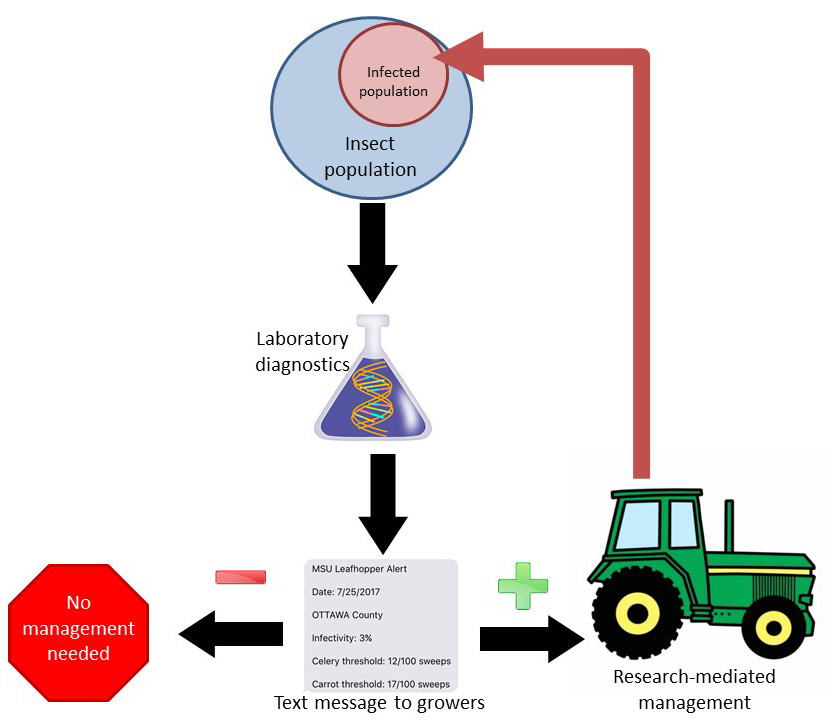MSU lab plays pivotal role in protecting Michigan’s vegetable crops
AgBioResearch Scientist Zsofia Szendrei uses novel procedure to test for damaging plant disease aster yellows

EAST LANSING, Mich. – Vegetable growers in Michigan have long sought a more rapid and efficient method to screen for the damaging plant disease, aster yellows. Primarily affecting carrots and celery in Michigan, aster yellows causes plants to have stunted or deformed growth, distorted or discolored foliage and a bitter taste, rendering infected plants unmarketable.
Nearly a decade ago, in stepped Michigan State University associate professor and vegetable entomologist Zsofia Szendrei to address disease response. Szendrei’s research, teaching and outreach center around the ecology and management of arthropods that occur in vegetable production. One such arthropod, the aster leafhopper, carries the pathogen causing aster yellows.
Szendrei has employed a laboratory procedure using a molecular biology technology called polymerase chain reaction – which amplifies samples of genetic code, allowing researchers to analyze it more clearly. It tests leafhopper specimens to estimate the percentage of aster yellows infected insects in any given field. Funding for Szendrei’s research came from MSU Project GREEEN, MSU AgBioResearch, the Michigan Vegetable Council and the Michigan Department of Agriculture and Rural Development (MDARD).

“The original protocols for aster yellows screening sometimes took days to get results. Growers can’t afford to spend that much time waiting to know if they need to spray, so we had to come up with a better solution for them,” Szendrei said.
Szendrei’s lab partnered with the Michigan Celery Promotion Cooperative, Michigan Carrot Committee, and MSU Extension to build a diagnostic network for the screening of aster leafhopper infestations. Growers, field managers, scouts, or MSU Extension specialists conduct periodic sweeps of vegetable crops around the state to collect leafhopper specimens that are then brought to the lab. In as little as 24 hours, Szendrei can send a group-text to the growers with the results.
“The growers have really embraced this program,” Szendrei said. “Having this technology at their service and being able to receive accurate data in real-time has made a big difference in their fields.”
Michigan’s carrot and celery growers are integral to the state’s agricultural economy, which prides itself on its variety of commodities as the second most agriculturally diverse state in the U.S. Michigan’s carrot growers produce approximately 150 million pounds of carrots, worth $15 million per year. The celery industry generates approximately $19 million annually from 110 million pounds grown. The state ranks fourth nationally for carrot production and second nationally for celery.

“Michigan agriculture would not be what it is without the success of our vegetable growers and the support they receive from researchers at MSU,” said Jamie Clover Adams, executive director of the Michigan Carrot Committee, Michigan Asparagus Committee and former director of the Michigan Department of Agriculture and Rural Development. “If our growers didn’t have the information and resources provided by Zsofia and the other vegetable researchers at MSU to combat disease and the various other issues vegetable crops face, our growers might not be growing carrots. Having resources at MSU to support the wide variety of our growers is important for the state's economy and the economy of a lot of communities where these crops are grown and processed.”
Partnerships on the farm
Ralph Oomen and his son, Tyler, own and operate Oomen Veggie Co. in Oceana County, a 1,800-acre farm with a diverse crop rotation that includes carrots among various other vegetables. Oomen has been farming since 1983 and has partnered with MSU on research and outreach projects for nearly as long.
“We have been cooperating with MSU researchers for as long as I can remember. No research means no future is the way I see it,” Ralph Oomen said. “For a vegetable-crop farm or specialty-crop farm no one does your research unless you get someone from the university’s attention to help you out, and we've been very fortunate that MSU has worked with us. We partner with them to host research and share results and we use the information from them to guide our management. It’s been a pretty good partnership over the years.”
Oomen credits Szendrei’s aster yellows program for changing the way carrot and celery growers scout, collect, test and interpret aster leafhopper infestation and the risk of aster yellows infection. More precision and more data have allowed Oomen and other growers to be strategic about their pesticide usage.
Only approximately 5% of aster leafhoppers carry the aster yellows pathogen, but even small outbreaks have resulted in significant yield reduction, averaging 25% in carrots and occasionally rising as high as 80%.
The only effective means of preventing the spread of aster yellows is to reduce the leafhopper population through pesticide applications. To do this, growers need a rapid and accurate estimate of the number of leafhoppers in their fields and also the number of those infected with the aster yellows phytoplasma.
“In the old days, we had a threshold of say, 15 aster leafhoppers per 100 sweeps. If you hit that number, you sprayed. Over the years, we started to test aster leafhoppers for aster yellows, but the test wouldn’t come back for a number of days and by that time you've already had to spray your fields,” Oomen said. “Zsofia took that original research and developed her method, which can tell us what infectious rate the leafhopper has within 24 hours or so. Now we know whether we have to spray in real-time, because we can change our threshold compared to how infected the leafhopper is now.”

Oomen has reduced his inputs since Szendrei’s aster yellows screening program went live a few years ago, but more importantly for vegetable growers, the rapid information of infection rates allows growers to make decisions based specifically on farm needs at any given time.
“In the long run we have used less insecticide, because of Zsofia's program. But there have been years, 2021 was a perfect example, where we used more insecticide than normal, but we were doing it for the right reasons,” Ooman said. “We knew that the infection rate in the leafhoppers was high at that time because of the testing and we had to spray a lot more that year, but we knew it was necessary because we had the data.”
Oomen said the program provides some peace of mind for growers, knowing that they always have a good gauge on the threat levels posed by the aster leafhopper and can get real-time information on when to treat their fields and when to save their insecticide for future use.
“Aster yellows used to be a major concern for us, but we don't worry about it like we used to, because we have the information to handle the leafhopper in the proper ways. We have had some big losses from aster yellows in the past, but we worry about it much less now that we have this program,” Ooman said. “As a vegetable grower and a member of the [Michigan] Carrot Committee we are now trying to make sure Zsofia has the economic resources she needs to continue doing this work because it is a big plus for our growers.”
Clover Adams said the economic benefits of Szendrei’s aster yellows program were wide-ranging, not only saving farmers on input costs and improving the quality and quantity of their crops but also ensuring the state’s processing industries have enough carrots to support their demand. Michigan’s carrot farms primarily grow processing carrots, which are supplied to the state’s various vegetable freezing, canning and processing companies, including the Gerber Products Company in Fremont, Michigan.
“Protecting our carrot crops is vitally important to our processing companies in the state because carrots are a big part of what they do. If we have unmarketable carrots or lose say 20 or 30% of the crop due to infection, that doesn’t just impact our growers but has downstream impacts on those producers, who then may have to go somewhere else to get their carrots that year,” Clover Adams said.

Michigan State University Extension vegetable educator Ben Werling works closely with Oomen and other Michigan growers to provide valuable research information to growers. Werling primarily collaborates with commercial vegetable producers in West Central and Northwest Lower Michigan.
“Our growers really value the information we can provide from the aster yellows program. I will collect leaf hoppers weekly from carrot farms in the state and overnight ship them to Zsofia,” Werling said. “Growers will now be literally standing by their sprayer and looking at the text from Zsofia and decide whether to spray insecticide that week or not. The beauty is that the process is really streamlined and information gets right to the grower.”
Clover Adams said the partnerships between MSU AgBioResearch, MSU Extension, MDARD and the state’s various commodity organizations ensure growers across the state have the tools needed to address threats to their crops, maintain healthy yields, and minimize the amount of spray going onto fields and farmland.
“We’ve established a nice collaboration, where we can share information and resources between our various stakeholders that makes a really good partnership,” Clover Adams said. “Food matters to people, and it’s fulfilling to work where I can positively impact people in many ways. Our vegetable growers face a lot of very significant concerns, but they're problem-solving people. Our job is to provide them the resources and information they need to make solving those problems easier.”



 Print
Print Email
Email




